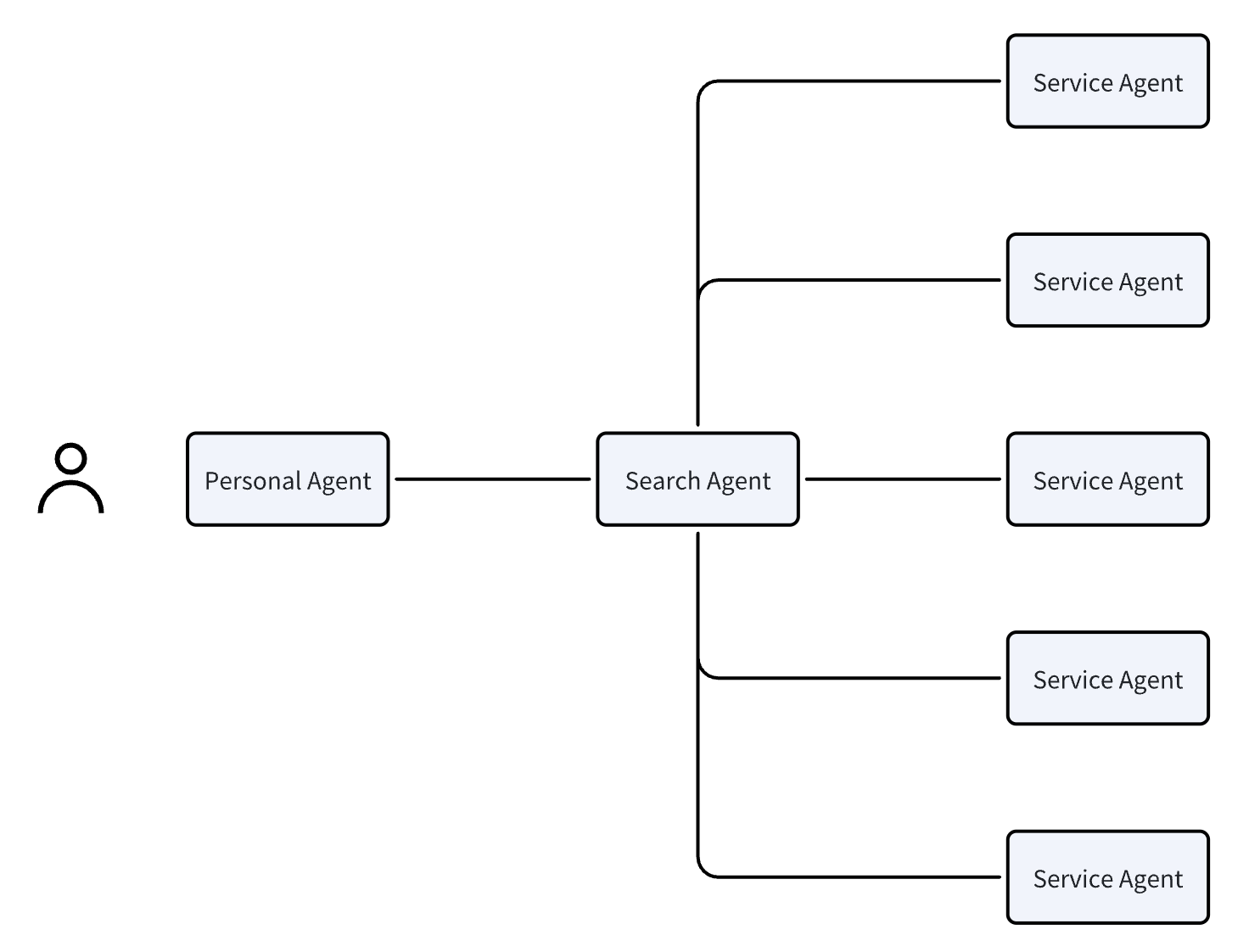Hotel Booking
Scenario Overview: Dixon is planning a vacation to Paris and needs to book a hotel that matches his preferences. He decides to let his Personal Agent handle this task, demonstrating the complete workflow of modern agent collaboration.
Step 1 - Requirements Analysis and Search: Dixon's Personal Agent, based on previously authorized access to personal data (including hotel preferences: 4-star or above, close to city center, with gym; vacation dates: March 15-22; budget range: 200-400 euros per night), uses the agent protocol to send a structured search request to the Search Agent. The Search Agent performs matching within its maintained global hotel agent network and quickly returns information for 100 qualifying hotel Service Agents.
Step 2 - Information Collection and Filtering: The Personal Agent uses Dixon's identity credentials to concurrently access these hotel Service Agents, requesting detailed information (real-time room rates, available room types, specific locations, facilities and services, user reviews, etc.). Each hotel Service Agent, recognizing potential customer access, proactively provides detailed service information and promotional offers. After collecting all information, the Personal Agent applies Dixon's personal preference algorithm to filter 8 best-matching hotel options from the 100 choices, ranking them by match score before pushing them to Dixon.
Step 3 - Booking and Payment: After reviewing the Personal Agent's recommended options, Dixon selects the second-ranked boutique hotel (because the top-ranked hotel had noise issues mentioned in reviews). The Personal Agent immediately establishes a booking session with that hotel Service Agent, completing room reservation and booking confirmation. However, due to security policies, the Personal Agent lacks payment authorization. After Dixon receives the successful booking notification, he completes payment through a secure payment interface. Once payment is completed, the Personal Agent automatically notifies the hotel Service Agent of the payment status and saves the complete booking information (confirmation number, check-in details, hotel contact information) to Dixon's personal travel profile.
Collaboration Value: Throughout this process, the Personal Agent serves as Dixon's digital representative, the Search Agent provides agent discovery services, and the hotel Service Agent provides professional services. All three achieve seamless collaboration through standardized agent protocols, significantly improving booking efficiency and user experience.
Requirements: Agent Identity Authentication, Agent Discovery, Agent Description, Agent Information Interaction, Agent Transactions, Privacy Protection, Identity Interoperability
Meeting Scheduling and Online Meeting Arrangement
Scenario Overview: Alice wants to have an online meeting with Bob. Alice tells her Personal Agent to schedule an appointment with Bob. Alice's Personal Agent organizes the meeting topic, expected duration, time zone, Alice's available time and preferences (such as weekday mornings, Wednesday priority, preferred video conferencing platform, etc.), and uses authorized contact information and identity credentials to contact Bob's Personal Agent through the agent protocol.
Step 1 - Information Organization and Request Initiation: Alice's Personal Agent generates a structured request (including agenda, objectives, candidate time windows, time zone, duration, preferred platform, participants, etc.) and sends it to Bob's Personal Agent; both parties use end-to-end encrypted channels for secure interaction.
Step 2 - Initial Negotiation and Option Generation: Bob's Personal Agent automatically avoids conflicts and constraints (lunch breaks, business trips, do-not-disturb periods, etc.) based on Bob's schedule and preferences, and conducts initial negotiations with Alice's Personal Agent to form several reasonable candidate time slots and meeting configuration options.
Step 3 - User Selection and Confirmation: Bob's Personal Agent presents the candidate options to Bob. After Bob selects one, Bob's Personal Agent sends the selection result and meeting elements (time, platform link, agenda summary) to Alice's Personal Agent. Alice's Personal Agent presents this option to Alice for confirmation.
Step 4 - Iterative Negotiation and Completion: If Alice agrees, both Personal Agents complete the confirmation and generate the final schedule and invitation (which may include ICS/calendar events, video conference links, meeting instructions, reminder settings), synchronize to both parties' calendars and notify participants; if Alice disagrees, Alice's Personal Agent sends back preference or constraint changes, and both parties continue negotiating until consensus is reached.
Collaboration Value: The two Personal Agents conduct information-minimized exchange and automatic negotiation based on standardized protocols, quickly converging under cross-time zone and complex constraint conditions, reducing repetitive communication costs, and improving meeting scheduling efficiency and privacy protection levels.
Requirements: Agent Identity Authentication, Agent Discovery, Agent Description, Agent Information Interaction, Privacy Protection, Identity Interoperability
